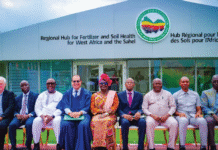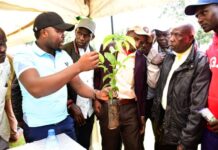By Dr. Chris Macoloo
Planting trees is one of the more effective ways to counter the effects of climate change. Numerous initiatives, some that entail spending hundreds of millions or even billions of dollars, seek to plant new trees and replace those eliminated through clear cutting and other techniques. Late last year India, Malaysia, Indonesia and the Philippines committed to planting trees to restore 64 million acres of degraded land by 2030. Countries in the Sahelian region of Africa have also committed to planting trees at the edge of the Sahara Desert to stop its expansion southwards and combat desertification. This is a project led by the African Union and involves creating a ‘Great Green Wall’ from Senegal in the west to Djibouti in the east.
Planting trees can be especially effective in developing countries, where climate change increasingly affects agriculture, water supplies and migration. While it will take much more than retaining and increasing the number of trees to prevent large-scale harm to communities seeking to escape poverty, they can play an important role in helping catalyze sustainable economic and social development.
Agroforestry Takes Root in East Africa
That is exactly what is happening in communities in Tanzania and Kenya.

Trees are an important part of both countries’ economies. They are used for fuel and building. Gathering branches for fuel can take up much of a girl or woman’s day, time which could otherwise be spent on agricultural work, a home-based business or education. In addition, a lack of wood for fuel can drive villagers into public forests. While taking wood for fuel is understandable, it is one of the factors leading to deforestation, and one of the very reasons foundations, governments and others are investing in tree planting.
World Neighbors, working with local partners, has helped communities in Tanzania and Kenya plant and manage tens of thousands of trees. These include fast-growing varieties whose branches can be harvested more quickly, providing a steady source of fuel for cooking and other needs. Surplus is sold to neighbors, increasing family incomes. Since the woodlots are near villages, there is no longer the need to travel far and spend a great deal of time gathering fuel. That time can be used in farming and other activities, raising agricultural output and income. This is especially important for women, who gather wood and have lower labor participation rates. In addition, fast-growing trees reduce or eliminate pressure to cut down trees in public forests.
Villagers also plant fruit and non-fruit trees near and among fast-growing varieties. This is an effort to create what are called ‘food forests’, a practice that addresses both community food needs and ecosystem regeneration. Food forests protect the soil, recycle nutrients and conserve water, very crucial mitigation and adaptation measures for responding to climate change effects. The fruit trees cultivated are mainly oranges, mangoes, lemon, pawpaw, and avocado. These fruit trees are primarily used to provide fruits as a strategy for increasing food and nutrition security and improving soil health. Surplus produce is sold in local markets, increasing incomes.
The most common non-fruit trees include casuarina, croton, moringa, grevillea, acacia (meransii and tortilis) and eucalyptus. Casuarina provides firewood and is used for fencing. Eucalyptus leaves have medicinal properties that can relieve pain and cold symptoms. Acacia spp provides fodder for livestock.
Agroforestry is also pivotal to increasing tree cover. Since it is practiced on individual farms, farmers are more willing and motivated to plant and manage the trees compared to those cultivated in communal areas. Smallholder farmers constitute over 80% of farmers in Kenya. If even a third of these farms engage in agroforestry, it would make a significant contribution to increasing tree cover in the country. This would help absorb carbon dioxide and help mitigate the effects of climate change.
Challenges
While very promising, there are challenges to wide-scale agroforestry in Tanzania, Kenya and other countries. An important hindrance can be the time frame involved in planting, cultivating and making use of certain tree species. Benefits are medium to long term. Improvements in soil health, and tree products such as timber, firewood and fruit are often realized after a couple of years. This can understandably prove a disincentive to farmers with immediate income needs.
In addition, many farmers have small pieces of land, on average 2 to 3 acres. Many farmers view agroforestry practices as competing with other profitable land uses such as cropping and livestock rearing. Trees are seen as competing with crops for the available and limited essential resources such as labor, water and nutrients.
Farmers also initially lack the necessary skills and technical know-how needed for establishing and managing agroforestry systems. Such skills include establishing tree nurseries and tree management practices such as pruning, thinning, pollarding and coppicing. To address this, World Neighbors partners with other organizations and government departments to invest in the necessary skills training.
Perhaps most important, agroforestry requires modest investment by farmers. This includes tree seedlings and other inputs as well as labor to tend trees. Investment capital in rural villages can be scarce or accessed at relatively high rates of interest. It can be particularly difficult to obtain loans for a novel investment like agroforestry.
Savings and Credit Key to Success
It is for this reason World Neighbors introduces savings and credit programs alongside agroforestry and other projects. In a savings and credit program, farmers contribute small amounts each month. When enough capital is amassed, participants take out loans at very low or no interest. Loans are invested in tree seedlings and other agroforestry inputs. A portion of profits from increased output are reinvested in the program, increasing the capital pool available for loans and investment to community members. Because a savings and credit program is neighbors loaning money to neighbors, repayment terms can be adjusted if necessary, and there are no onerous fees. This helps encourage the kind of patient capital necessary for agroforestry and similar investments that provide returns over a longer time horizon. This capital controlled by communities and used for community needs.
The challenges to agroforestry are being overcome. Planting trees in Tanzania and Kenya is mitigating the effects of climate change. Food-producing trees addressing nutrition challenges. The initiatives are increasing household incomes. And through the capital accumulation necessary to engage in it, agroforestry is serving as the basis for business development at a scale capable of lifting communities out of poverty.
Agroforestry is one of many innovations that demonstrate that sustainability and economic development can go hand in hand.
Dr. Chris Macoloo is Regional Director for Africa at World Neighbors.










[…] article originally appeared on farmersreviewafrica.com on February 22, […]
Comments are closed.